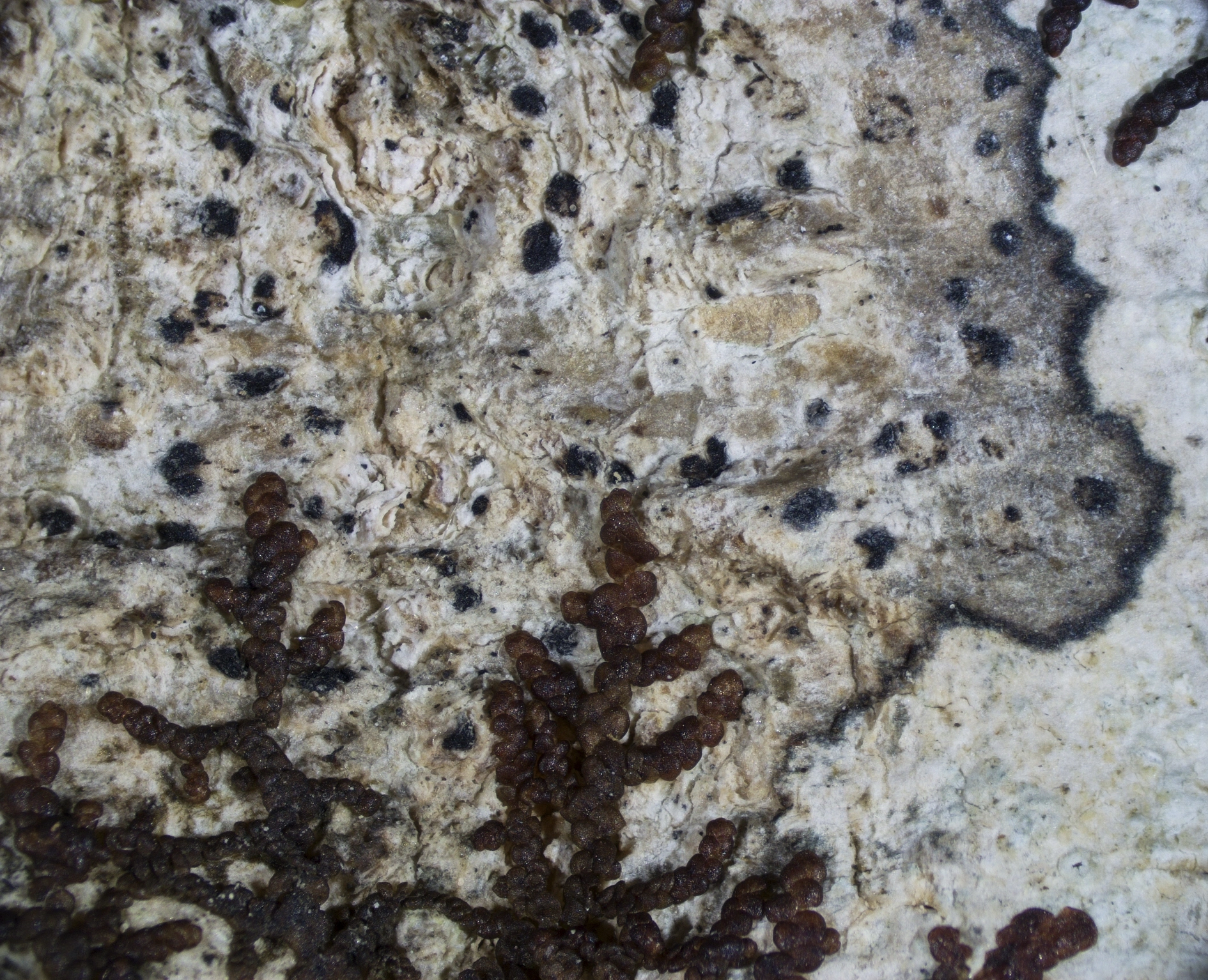Arthothelium dictyosporum
Arthothelium dictyosporum collected from Fraxinus excelsior at Nedrevåg-Blåberget in Tysnes (O-L-221300).
Arthothelium dictyosporum is a highly oceanic species that is known from a single locality in Vestland. It is characterized by brownish black maculate apothecia on a thin brownish-grey to fawn thallus with trentepohlioid photobiont. The brown and warted spores are divided by 3–4 transverse and 1–4 longitudinal septa. The apical cell is enlarged.
- Innhold
- Description
- Ecology
- Distribution in Norway and the Nordic countries
- Global distribution
- Similar species
- Remarks
Description
Thallus
The thallus is pale brownish grey or fawn. It is continuous or cracked, immersed in the bark, and has a smooth, matt to weakly glossy surface. The margin is not determinate or bordered by a brown line. The photobiont is a species of the family Trentepohliaceae.
Fruitbodies
The apothecia are level with the thallus or slightly raised, rounded, angular or shortly elongate in shape, brownish black, and without pruina. They are 0.3–0.8 × 0.15–0.3 mm in size and 80–200 μm tall. The disc is flat or slightly convex.
The epithecium is brown and 7–15 μm tall.
The hymenium is colorless and 60–90 μm tall.
The hypothecium is unpigmented or pale brown and 10–85 μm tall.
The paraphysoids are 1–2 μm wide. Their tips are widened to 2.5 µm, with brown pigment deposited on the outer walls which occasionally forms distinct caps.
The asci are of the Arthonia-type and contain 8 spores.
The spores are colorless first, with a brown pigmentation and granular ornamentation when old. They are oblong with an enlarged and undivided apical cell, 28–33 × 9–12 μm in size, and divided 5–7 transverse septa and 1–2 longitudinal septa in the central cells.
Anamorph
Pycnidia are sparse, brownish black, immersed in the thallus or slightly raised, and 60–80 µm in size. The wall is reddish brown. The rod-shaped conidia are 4.5–6.5 × 0.6–0.8 μm large.
Chemistry
The thallus does not react with C, K, KC, Pd, or UV (C–, K–, KC–, Pd–, UV–). Lichen secondary compounds have not been detected by TLC.
The brown pigment in the epithecium and in the wall of the pycnidia changes to greenish in K solution.
Ecology
Arthothelium dictyosporum has been found in Norway in an ash dominated boreo-nemoral rain forest in a steep boulder-slope, together with Coniocarpon fallax. It grew in dense forest on the smooth bark of European ash (Fraxinus excelsior). It is a highly oceanic, warm-temperate species that has also been found on smooth bark of common hazel (Corylus avellana), holly (Ilex aquifolium) and rowan (Sorbus aucuparia) as well as on rough bark of willow (Salix spp.) in old woodlands in the British Islands, and in laurel forests in Tenerife.
Distribution in Norway and the Nordic countries
Arthothelium dictyosporum is in the Nordic Countries confined to Norway. The species is known from Tysnes municipality in Vestland.
Global distribution
Outside the Nordic Countries, Arthothelium dictyosporum is known from highly oceanic habitats in Scotland and NW England (Cumbria), the Canary Islands and the Pacific Coast of North America.
Similar species
Arthothelium dictyosporum can be distinguished from the similar Arthonia ilicina by the muriform versus transversely septate spores that turn brown with a distinct granular ornamentation in the spore wall when old. The two species occur in similar habitats.
Remarks
Arthothelium dictyosporum appears to be a rare species in Norway that may have been overlooked due to its superficial similarity with Arthonia ilicina. It is likely confined to the highly oceanic forest communities and woodlands including boreo-nemoral rainforests in western Norway. Additional localities may be found upon increased mapping activities.
Literature
Cannon P, Ertz D, Frisch A, Aptroot A, Chambers S, Coppins BJ, Sanderson N, Simkin J and Wolseley P (2020). Arthoniales: Arthoniaceae. Revisions of British and Irish Lichens 1: 1–48.
Coppins BJ and James PW (1979). New or interesting British lichens III. Lichenologist 11: 27–45.
Ertz D and Diederich P (2008). Lichens and lichenicolous fungi new for Tenerife (Canary Islands). Cryptogamie, Mycologie 29(4): 389–396.
Frisch A, Klepsland J, Palice Z, Bendiksby M, Tønsberg T and Holien H (2020). New and noteworthy lichens and lichenicolous fungi from Norway. Graphis Scripta 32(1): 1–47.

